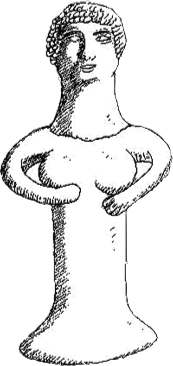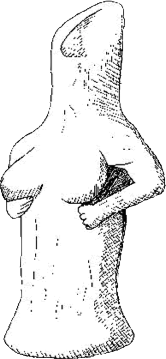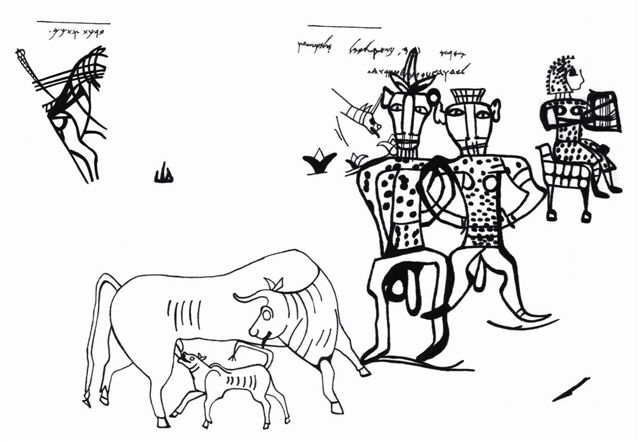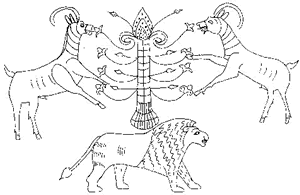Johanna H. Stuckey - Goddess in the Spotlight
bron: www.matrifocus.comby Johanna H. Stuckey, University Professor Emerita, York University
Lammas 2004, Vol 3-4
MatriFocus, a Cross-Quarterly Web Magazine for Goddess Women Near & Far
Asherah and the God of the Early Israelites

Clay pillar figurine
Israel, 9th Century BCE
S. Beaulieu, after Patai 1990
Unquestionably, 'the asherahs' were usually wooden; they stood upright, often beside altars, along with stone pillars. However, in at least eight instances, they are described as carved (Pettey 1990:45). Thus, far from being merely wooden 'cult poles', they were probably quite large carved images. As was the case with cult statues in other areas of the Eastern Mediterranean, 'the asherahs' almost certainly would have been 'animated' ritually (Walker and Dick 1999:57). Thus they did not just represent the goddess, but actually were worshipped as Asherah herself. Further, according to the Bible, a statue of Asherah stood in the Solomonic temple in Jerusalem for about two-thirds of its existence (Patai 1990:50). Asherah "...must, then, have been a legitimate part of the cult of Yahweh." (Olyan 1988:13)
The Hebrew Scriptures regularly pair Asherah's name, especially 'the asherahs', with Baal's, so that some scholars have wondered whether Asherah had ousted Astarte as Baal's consort. In 1963 Yamashita noted that most of the references to Asherah in the Hebrew Bible, including those pairing Asherah with Baal, were associated with only one source (1963:123-137). Later, Olyan argued very convincingly that the biblical attacks on Asherah were "restricted to the Deuteronomistic History" (2) and to texts exhibiting Deuteronomistic influence. For instance, the numerous pairings of Baal with Asherah's 'cult symbol', called 'the asherah', are part of a reformist, monotheistic 'anti-asherah polemic' aimed at discrediting 'the asherah' by associating it with Baal and Astarte (Olyan 1988: 1, 3, 13-14). This polemic was necessary because Asherah "had some role in the cult of Yahweh; not only in popular Yahwism, but in the official cult as well." (Olyan 1988:74)
In addition to the testimony of the Hebrew Bible, there is also considerable archaeological evidence that may throw light on the role of Asherah in the religion of the early Israelites. First, a considerable number of small, clay, female statuettes, which archaeologists usually call 'pillar figurines', have been unearthed all over Israel. Dating to the eighth and early seventh centuries, that is, to the height of the Israelite monarchy, they occur in almost every excavation of the period (Kletter 1996: 4, 40-41). (3) So many pillar figurines have been excavated in the heartland of Judah that they are often regarded as "a characteristic expression of Judahite piety" (Keel and Uehlinger 1998:327; Kletter 1996:45).

Clay pillar figurine
Israel, 9th Century BCE
S. Beaulieu, after Patai 1990
Asherah, Yahweh's consort
Whatever explanation we give for both the textual 'asherahs' and the pillar figurines, it seems likely that, during the Israelite Monarchy, both were associated not with Canaanite worship, but with Israelite official and popular religion. That leads me to ask the obvious question: What was Asherah's role in Israelite religion? Could she have been the consort of the Israelite god? Relatively recently, startling archaeological discoveries in modern Israel have strengthened the arguments that Asherah was the Israelite god's consort (Hadley 2000: 86-102). One dig was in the heartland of Judah, the other in the northern Sinai. Several blessing inscriptions from the sites contain a controversial phrase possibly to be translated as "Yahweh and his Asherah." Even more exciting are drawings that accompany the inscriptions, especially those from the Sinai site (van der Toorn 1998:88-89).
The Sinai sketches appear on several pieces of pottery from two large jars found in a strange structure in the northern Sinai (Hadley 2000: 111, 119). One of the accompanying inscriptions reads: "I bless you by Yahweh of Samaria and his [/its] Asherah," while the two others use the formula: "I bless you by Yahweh of Teman (the South) and his [/its] Asherah" (van der Toorn 1998:89).

Jar A, drawing. Kuntillet Ajrud, Israel
Early 8th century BCE
S. Beaulieu, after Keel and Uelinger 1998
Others translators translate the pronoun as 'his', understanding it to be referring to the Israelite god, and so render the phrase as either "Yahweh and his asherah [cult object]" (Hadley 2000:124; Olyan 1988:33) or "Yahweh and his Asherah [goddess]" (van der Toorn 1998:90; Binger 1997:108; Patai 1990:53).
Associated with the inscriptions are some amazing drawings full of rich symbolism (Hadley 2000:116-119, nr. 4, 5, 6, 7). Fascinating and evocative, they provide considerable support for understanding 'asherah' as a goddess. Although there are drawings on two sides of one jar and on one side of the other, they do not appear to constitute "a coherent composition" (Beck 1982:4). Rather they present "a series of motifs," many of which would have been very familiar to most inhabitants of the ancient Eastern Mediterranean. One of the pictures depicts a cow suckling a calf, two standing figures, and one seated figure playing a lyre (Hadley 2000:115, nr. 3; Beck 1982:9, nr. 5). The blessing "by Yahweh of Samaria and his/its asherah" overlaps the headdress of the larger of the standing figures.
Some scholars, including the excavator of the site, consider the inscription to be connected to the drawing (Meshel 1986:239). A few then interpret the standing figures as possibly the Israelite god and Baal and the seated lyre player as possibly Asherah (Coogan 1987:119; McCarter 1987:146-147). However, another interpretation of this drawing seems more likely: Beck's carefully developed and widely accepted conclusion that the standing figures represent male and female Egyptian deities and the lyre player a temple musician (Hadley 2000:137-144; Keel and Uehlinger 1998:218; Beck 1982:4, 27-36).
Whatever the interpretation of the seated figure, there is certainly a goddess elsewhere in this picture: the cow suckling a calf (Hadley 2000:115, nr. 3). The cow-and-calf image, which had wide distribution in the ancient Eastern Mediterranean, was "one of the most popular motifs of the first millennium in Western Asia." It appears on many seals and on an "enormous quantity of ivory plaques," beautifully carved by Phoenician artists of the eighth and seventh centuries BCE (Beck 1982:120). The cow-and-calf motif is usually connected with the symbol system of goddesses (Keel and Uehlinger 1998:215).

Jar A, shoulder drawing. Kuntillet Ajrud, Israel
Early 8th century BCE
S. Beaulieu, after Bonanno 1985:336, nr. 21
Whoever did the drawings on the first jar understood the symbolic tradition of goddesses very well and, probably intentionally, brought goddesses into the pictures by using three of the most prominent and potent goddess allusions: cow and calf, lion, and sacred tree. However, the drawings may or may not depict Asherah, either in person as the lyre player or in the symbols. Beck, among others, thinks that it is "doubtful if [the] scenes [on the first jar discussed] were connected to any particular deity" (Beck 1982:16). On the other hand, those who argue that the drawings show or allude to Asherah also use that possibility as support for interpreting the inscriptions as referring to her (Hadley 2000:152,153; Keel and Uehlinger 1998:236). For them, then, the drawings clarify the inscriptions and point to Asherah, both in Israel and in Judah, as the consort of the early Israelite god (Jahweh).
As for me, I tend to agree that Asherah was probably consort of the Israelite god. It seems likely that, in Canaan, the early Israelites, originally pastoral semi-nomads, were slowly becoming settled agrarians. As such they would have needed to worship deities who promoted their farming activities: a heterosexual couple one of whose concerns was the land's fertility.
In that worship they would be like the cultures surrounding them. What would be more natural, then, than their adopting and adapting deities from the agrarian peoples among whom they were settling? So they identified their main god with Canaanite El (5) and, as consort for their own god, took over El's female counterpart Asherah.
Footnotes (1) All quotations from the Hebrew Bible come from Tanakh 1988. (2) The Deueronomistic History is "the theory of history in the biblical books Deuteronomy-2Kings and based on the hypothesis that these books were edited as a whole according to a consistent principle" (Bowker 1997: 271). (3) The dates of the monarchy are 900-539 BCE. It was in the latter part of the seventh century BCE that Josiah, King of Judah, began his drastic religious reforms. Josiah was "one of the great heroes of the Deuteronomists" (Binger 1997: 117). (4) A few scholars have put forward what is clearly a minority view: the word 'asherah' means 'sacred place'; so they translate the critical phrase as: "Yahweh of Samaria [or Teman] and his sanctuary" (Olyan 1988: 26, n. 16, n.19). (5) There is considerable evidence that they did. See John Day's Yahweh and the Gods and Goddesses of Canaan (Sheffield, UK: Sheffield Academic, 2000) Chap. 1.
terug naar God als man en vrouw
^